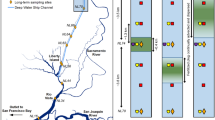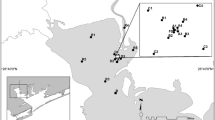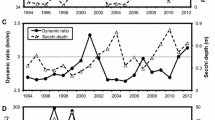Abstract
On September 6, 2000, the sewage outfall at the mouth of Boston Harbor was relocated 15 km offshore to alleviate pollution in Boston Harbor. The expected responses for nutrients and water column productivity parameters were for values to decrease at Boston Harbor, to increase at the outfall location, and to remain unchanged at the boundary of the near field region within 5 km of the outfall. Average values ofr water column measurements from 1992 to 2004 indicated these general responses with some exceptions. At the Harbor, nutrients decreased and chlorophyll increased but14C primary productivity remained statistically unchanged. At the new outfall location and at the boundary of the near field, nutrients increased and chlorophyll increased but primary productivity remained unchanged. Physical factors affecting primary production, such as pring water temperature, stratification, and wind, had more affects on productivity patters than nutrients from outfall relocation in the near field. A decrease in summer zooplankton after outfall relocation appeared to be due to a region-wide rather than outfall effluents.
Similar content being viewed by others
Literature Cited
Alber, M., J. Hallam, andM. S.. Connor. 1993. The state of Boston Harbor 1992. MWRA Environmental Quality Department Technical Report Series No. 93-6. Massachusetts Water Resources Authority. Boston, Massachusetts.
Albro, C. S., H. Trulli, J. Boyle, S. Sauchuk, C. Oviatt, C. Zimmerman, J. Turner, D. Borkman, andJ. Tucker. 1998. Combined work/quality assurance project plan (CW/QUAPP). MWRA Harbor and Outfall Monitoring Project, Battelle Duxtury Operations. Duxbury, Massachusetts.
Butman, B., M. H. Bothner, J. C. Hathaway, H. L., Jenter, H. J. Knebel, F. T. Manheim, and R. P. Signell. 1992. Contaminant transport and accumulation in Massachusetts Bay and Boston Harbor: A summary of the U.S. Geological Survey studies, U.S. Geological Survey Open-File Report 92-202. Woods Hole, Massachusetts.
Cole, B. E. andJ. E. Cloern. 1987. An empirical model of estimating phytoplankton productivity in estuaries.Marine Ecology Progress Series 36:299–305.
Costello, J. H., B. K. Sullivan, D. J. Gifford, D. Van Keuren, andL. J. Sullivan. 2006. Seasonal refugia, shoreward thermal amplification, and metapopulation dynamics of the ctenophoreMnemiopsis leidyi in Narrangansett Bay, Rhode Island.Limnology and Oceanography 51:1819–1831.
Cropp, R. K., J. T. Turner, D. G. Borkman, S. Embo-Mattingly C. D. Hunt, and K. E. Keay. 2003. A review of the zooplankton community in the Massachusetts Bay/Cape Cod, Bay system. Massachusetts Water Resources Authority, Report ENQUAD 2003–06. Boston Massachusetts.
Deason, E. E. 1980 Grazing ofAcartia hudsonica (A. clausi) onSkeletonema in Narragansett Bay (USA): Influence of food concentrations and temperatureMarine, Biology 60: 101–113.
Geyer, W. R., G. B. Gardner, W. S. Brown, J. Irish, B. Butman, T. Loder, andR. P. Signell. 1992. Final Report: Physical Oceanographic Investigation of Massachusetts and Cape Cod Bays. Massachusetts Bays Program of the U.S. Environmental Protection Agency. Massachusetts Executive Office of Environmental Affiars, Coastal Zone Management. Boston, Massachusetts.
Giblin, A. E., C. S. Hopkinson, andJ. Tucker. 1997. Benthic metabolism and nutrient cycling in Boston Harbor Massachusetts.Estuaries 20:346–364.
Hyde, K. W. 2006. Interannual and seasonal phytoplankton variability in Massachusetts Bay from remote and in situ measurements. Ph.D. Dissertation, University of Rhode Island, Narrangansett, Rhode Island.
Keller, A. A., C. A. Oviatt, H. A. Walker, andJ. D. Hawk. 1999. Predicted impacts of elevated temperature on the magnitude of the winter-spring phytoplankton bloom in temperature coastal waters: A mesocosm study.Limnology and Oceanography 44:344–356.
Keller, A. A., C. Taylor, C. Oviatt, T. Dorrington, G. Holcombe, andL. Reed. 2001. Phytoplankton production patterns in Massachusetts Bay and the absence of the 1998 winter-spring bloom.Marine Biology 138:1051–1062.
Kelly, J. R. 1997. Nitrogen flow and the interaction of Boston Harbor with Massachusetts Bay.Estuaries 20:365–380.
Kelly, J. R. andP. H. Doering. 1997. Monitoring and modeling primary production in coastal waters: Studies in Massachusetts Bay.Marine Ecology Progress Series 148: 155–168.
Lewis, M. andJ. Smith. 1983. A small volume, short-incubation-time method for measurement of photosynthesis as a function of incident irradiance.Marine, Ecology Progress Series 13:99–102.
Libby, S. C., Gagonon, C. Albro, M. Michelson, A. Keller, D. Borkman, J. Turner, and C. Oviatt. 2002. Combined work/quality assurance plan for baseline water quality monitoring: 2000–2005In Massachusetts Water Resources Authority, Report, ENQAD ms-074 Boston, Massachusetts.
Link, J. andM. Ford. 2006. Widespread and persistent increase ofCtenophora in the continental shelf ecosystem off NE USA.Marine Ecology Progress Series 320: 153–159.
Lohrenz, S. E., G. L. Fahnenstiel, andD. G. Redalje. 1994. Spatial temporal variations of photosynthetic parameters in relation to environmental conditions in coastal waters of northern Gulf of Mexico.Estuaries 17: 779–795.
Massachusetts Water Resources Authority (MWRA). 1991. Massachusetts water resources authority effluent outfall monitoring plan Phase 1: Baseline studies. MWRA, Boston, Massachusetts.
Nowicki, B. L., J. R. Kelly, E. Requintina, andD. Van Keuren. 1997. Nitrogen losses through sediment denitrification in Boston Harbor and Massachusetts Bay.Estuaries 20:626–639.
O'Reilly, J. E. andD. A. Busch. 1984. Phytoplankton primary production on the northwestern Atlantic shelf.Rapports et Process-Verbaux des Reunions Conseil International pour I' Exploration de la Mer 183:255–268.
Oviatt C. A. 2004. The changing ecology of temperate coastal waters during a warming trend.Estuaries 27:895–904.
Oviatt, C. A. andK. Hindle. 1994. Manual of biological and geochemical techniques in coastal areas, 3rd edition Series Report No. 1, Marine Ecosystems Research Laboratory, Narragansett, Rhode Island.
Platt, T., C. L. Gallegos, andW. G. Harrison. 1980. Photoinhibition of photosynthesis in natural assemblages of marine phytoplankton.Journal of Marine Research 38:687–701.
Rex, A. C. and M. S. Connor. 1997. The state of Boston Harbor 1996: Questions and answers about the new outfall. Massachusetts Water Resources Authority Technical Report N. 97-5. Boston, Massachusetts.
SAS. 1988. SAS procedures guide, release 6.03 edition. SAS Institute. Cary, North Carolina.
Siegel, D. A., S. C. Doney, andJ. A. Yoder. 2002. The North Atlantic spring phytoplankton bloom and Sverdrup's critical depth hypothesis.Science 296:730–733.
Strickland, J. D. H. and T. R. Parsons. 1972. A Practical Handbook of Seawater Analysis, 2nd edition. Fisheries Research Board Canada Bulletin, 167, Ottawa, Canada.
Sverdrup, H. U. 1953. On conditions for the vernal blooming of phytoplankton.Journal du Conseil International pour I'Exploration de la Mer 18:287–295.
Townsend, D. W. andR. W. Spinard. 1986. Early spring phytoplankton blooms in the Gulf of Maine.Continental Shelf Research 6:515–529.
Travis, J. 1993. Invader threatens Black, Azov Seas.Science 262: 1366–1367.
Webb W. L., M. Newton, andD. Starr. 1974. Carbon dioxide exchange ofAlnus rubna: A mathematical model.Ocealogia 17: 281–291.
Yentsch, C. S. andD. W. Menzel. 1963. A method for the determination of phytoplankton chlorophyll and phaeophytin by fluorescence.Deep-Sea Research 10:221–231.
Author information
Authors and Affiliations
Corresponding author
Rights and permissions
About this article
Cite this article
Oviatt, C.A., Hyde, K.J.W., Keller, A.A. et al. Production patterns in Massachusetts Bay with outfall relocation. Estuaries and Coasts: J ERF 30, 35–46 (2007). https://doi.org/10.1007/BF02782965
Received:
Revised:
Accepted:
Issue Date:
DOI: https://doi.org/10.1007/BF02782965




